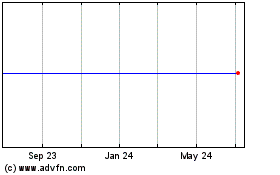Edited Video of Pelosi Ripping Trump's Speech Renews Debate Over Manipulated Content
February 07 2020 - 6:07PM
Dow Jones News
By Jeff Horwitz and Natalie Andrews
President Trump posted a heavily edited video attacking House
Speaker Nancy Pelosi this week, sparking a feud highlighting the
gray areas that persist about what manipulated content is
permissible on social media.
In the video, Mrs. Pelosi (D., Calif.) appeared to be ripping up
a copy of Mr. Trump's State of the Union address during the points
of his remarks when U.S. citizens and military members were being
honored with applause. Mrs. Pelosi only tope up the script once, at
the end of the speech.
A White House spokesman didn't immediately return a request for
comment about the video.
In less than 24 hours, the video was viewed millions of times
across Facebook Inc. and Twitter Inc. The video was especially
popular on Instagram, owned by Facebook, where it garnered more
than four million views.
Disagreements over the video triggered a spat on Twitter on
Friday between Drew Hammill, Mrs. Pelosi's deputy chief of staff,
and Andy Stone, a longtime Facebook spokesman. Mr. Hammill urged
Facebook and Twitter to take down the video because it was
"deliberately designed to mislead and lie to the American
people."
To that, Mr. Stone responded, "Sorry, are you suggesting the
President didn't make those remarks and the Speaker didn't rip the
speech?"
Eight minutes later, Mr. Hammill shot back: "what planet are you
living on? this is deceptively altered. take it down."
Under Facebook's rules on "manipulated media," announced last
month, only videos altered with artificial intelligence or
deep-learning techniques are eligible for immediate takedown by the
platform. Because the State of the Union video was altered using
conventional video editing, it could be reviewed by Facebook's
outside fact-checking partners, at which point it could be labeled
as misleading and its future spread on the platform slowed.
Fact-checkers hadn't reviewed the video as of Friday
afternoon.
The dispute mirrors a similar fight that played out on Facebook
last year, when a video of Mrs. Pelosi was misleadingly edited to
create the impression that she was slurring her words as if
intoxicated. The video was shared by conservative Facebook pages
and viewed millions of times. At the time, Mrs. Pelosi likened the
social-media company's handling of the altered video to its failure
to prevent Russia's interference in the 2016 elections.
It was eventually fact-checked and marked as misleading after a
lengthy public dispute but allowed to remain on the platform.
Facebook has previously said the company takes no position on
whether particular pieces of content should be found false or
misleading by its fact-checking partners.
Twitter, meanwhile, declined to say whether the State of the
Union video might be covered under its policy on manipulated media
announced in November. Under that policy, which hasn't taken effect
yet, misleadingly edited videos would be labeled as such on the
platform, though not taken down.
"We won't begin labeling or enforcement action until March 5,
2020, so I can't get into hypotheticals," a Twitter spokeswoman
said.
Several Democratic lawmakers, including Rep. Ro Khanna of
California, called on social networks to take the video down
because it spreads false information.
"It's the juxtaposition that makes it false," Mr. Khanna said in
an interview. "If they are willing to take down posts that violate
copyright, don't you think they could take down posts that have
false content?"
Mrs. Pelosi said she "tore up a manifesto of mistruths" on
Tuesday night and told reporters in her press conference on
Thursday that she did this while the cameras were on to "get the
attention of the American people to say, 'This is not true, and
this is how it affects you.'"
Deepa Seetharaman contributed to this article.
Write to Jeff Horwitz at Jeff.Horwitz@wsj.com and Natalie
Andrews at Natalie.Andrews@wsj.com
(END) Dow Jones Newswires
February 07, 2020 17:52 ET (22:52 GMT)
Copyright (c) 2020 Dow Jones & Company, Inc.
Twitter (NYSE:TWTR)
Historical Stock Chart
From Mar 2024 to Apr 2024

Twitter (NYSE:TWTR)
Historical Stock Chart
From Apr 2023 to Apr 2024
